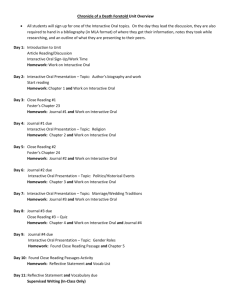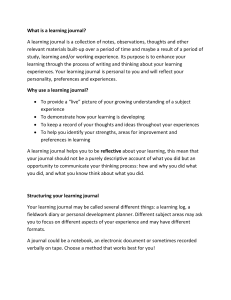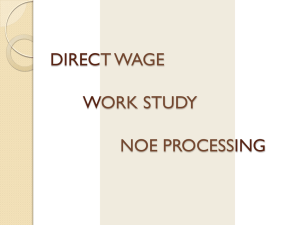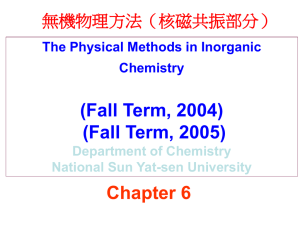File - Paola Treviño'sMaster's Porfolio
advertisement
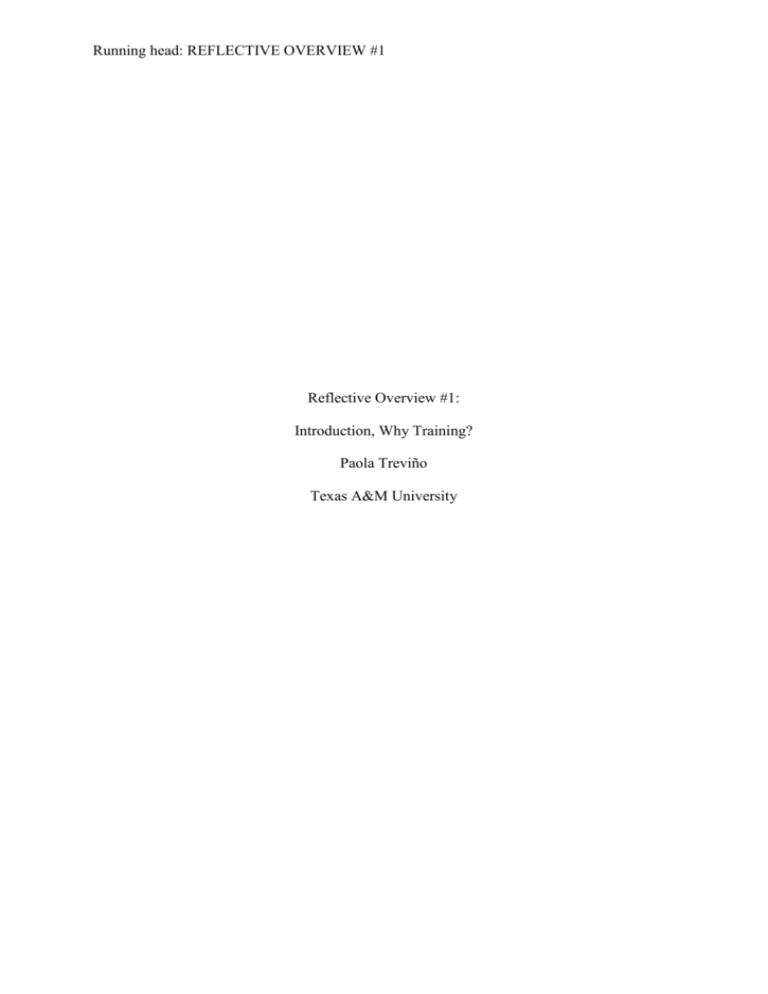
Running head: REFLECTIVE OVERVIEW #1 Reflective Overview #1: Introduction, Why Training? Paola Treviño Texas A&M University REFLECTIVE OVERVIEW #1 Reflective Overview #1 In reading over the chapters for this model there were a few points made which hit home and allowed me to reflect on how I can use these for my future Human Resources career. Many of the topics covered over the assigned readings explain how and why certain terms and descriptions help in training and development. Some may think training and development is a simple topic to learn, however there are many aspects involved in training and development we all need in our day to day lives. Training and development should be an essential factors considered in every organization/company. Without training and development organizations can pay farewell to their fate. In the introduction of Noe’s book “Employee Training and Development” the term training is defined and expanded upon. According to Noe (2010) “Training refers to a planned effort by a company to facilitate employees’ learning of job related competencies” (p.5). Training is needed by all employees no matter what level of the organization they may be a part of. In the reading about organizations who allow their managers to be in the front lines of customer service and experience how to handle and deal with customers, the managers get a much better understanding of what actually goes on the organization. With this experience, managers are able to help their employees and more importantly their customers. This also goes along with the term continuous learning, which is significant to training and development. When we continue to learn, this allows us to improve ourselves not only at work but also personally. Even as adults, we never stop learning, especially when it comes to the workplace. Every day there is something we can learn, whether it be due to a change, globalization, new employees and their cultures, new software programming etc. Learning is continuous, but sometimes employees need motivation through rewards or compensation to have a drive to continue their learning. Some employees have all the 2 REFLECTIVE OVERVIEW #1 knowledge and skills to perform their job duties however; they lack motivation to perform their job effectively. Motivation in learning can be tied with Maslow’s needs theory and also with the Expectancy Theory. In regards to Maslow’s needs theory, if an employee feels dissatisfied they will find motivation within themselves to become satisfied. Once they are satisfied in one area they will move on to the next level of satisfaction. The Expectancy Theory is based on what the employee expects. I can testify to this theory in saying, if one expects a certain outcome; they will do whatever it takes to make sure their expected outcome is reached. For example, around the same time every year we have performance evaluations, we know what is expected of us employees. In order to receive the outcome, which in many cases is a raise and/or promotion, we make sure all the requirements are met in order to receive what is expected. From my own experiences, I have been guilty of being motivated by the Expectancy Theory. As I mentioned earlier, once a year we have performance evaluations with our direct supervisor. In the performance evaluation meeting the topic of expectations is critical in receiving your raise and/or promotion. As the employee, I know what is expected of me and the requirements I must take to complete the expectations. Based on how well I performed and if the expectations were meet, I in turn will receive my outcome, a raise/promotion. In my case, the valence for this expectancy is significant, especially since I am personally motivated to receive a raise. For me this is my motivating force, I know what is expected of me and the outcome. In order to be compensated I must perform my expectations efficiently. While reading my classmate’s posts for this module, Sarah Cooper made a few great comments regarding Learning Theories. She too has experienced the Expectancy Theory at work and feels the same way I do, as this theory brings motivation across the board. She goes 3 REFLECTIVE OVERVIEW #1 on to state “While I completely agree, and see this theory as a staple as to how I have a job in corporate training, just training an employee will not create better performance. Training is a first step, and then after training follow-up must be done and coaching sessions must be made available in order to see the true value” (Cooper, 2013). Cooper makes a great point in this statement as training will not create better performance. Along with training you need support, motivating factors and follow-up sessions which will allow the employee to retain what was learned. It is very common to attend a training and development course, go back to work and forget everything you learned especially if it is not being frequently used. Having a follow-up to the training and development course will ensure the employee is retaining key information learned. This also provides the organization “more bang for their buck,” as employees continue to use what was learned instead of wasting their time and effort not applying what was learned to their job. In reading the first few pages of Noe’s chapter one, the three companies, Seattle City Light, Starbucks and US Airways Group motivated me to apply some of their strategies to my own practice. Starbucks stressed “the key to company success is its employees or partners,” which I agree with completely (Noe, 2010, p.3). Money and power are great to have, however if you do not value your employees and treat them with respect your organization will not last (Noe, 2010, p.3). These three organizations made vast efforts to train and develop their employees the best they can in order to provide their customers the best customer service. Although some organizations are not fans of the time and money training and development courses accrue, the return on investment is far greater than having lost time and money in training and development courses which do not fit their organization’s needs. 4 REFLECTIVE OVERVIEW #1 References Cooper, S. (2013, September 1). Learning Theories. Retrieved from https://courses.education.tamu.edu/mod/forum/discuss.php?d=427 Noe, R.A. (2010). Employee Training & Development (5th ed). New York: McGraw-Hill. 5

